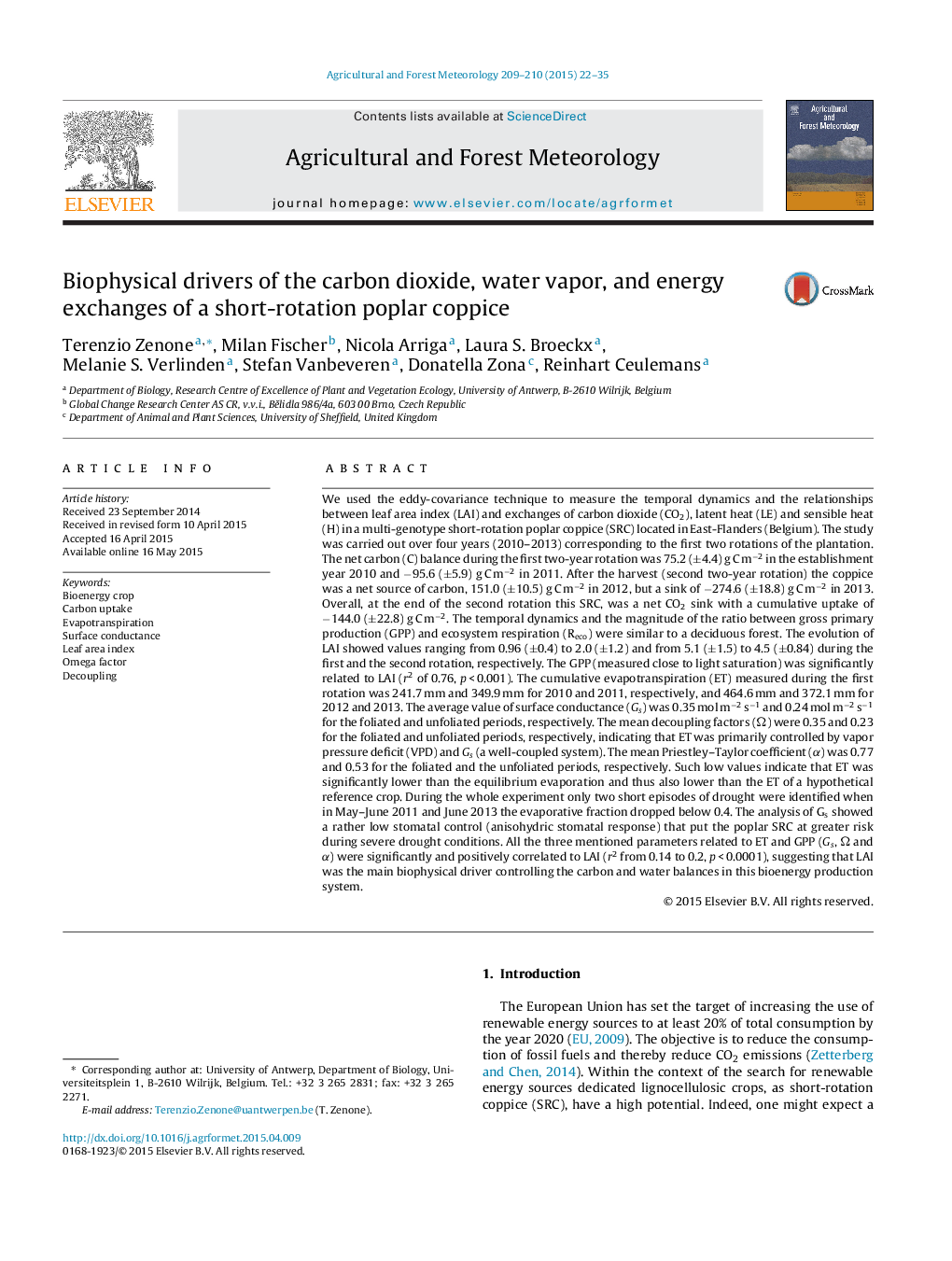| کد مقاله | کد نشریه | سال انتشار | مقاله انگلیسی | نسخه تمام متن |
|---|---|---|---|---|
| 6537279 | 158329 | 2015 | 14 صفحه PDF | دانلود رایگان |
عنوان انگلیسی مقاله ISI
Biophysical drivers of the carbon dioxide, water vapor, and energy exchanges of a short-rotation poplar coppice
ترجمه فارسی عنوان
رانندگان بیوفیزیکی دی اکسید کربن، بخار آب و مبادلات انرژی یک جنگل باقلا سبز
دانلود مقاله + سفارش ترجمه
دانلود مقاله ISI انگلیسی
رایگان برای ایرانیان
کلمات کلیدی
محصول بیو تکنولوژی، جذب کربن، تبخیر تعرق، هدایت سطح، شاخص منطقه برگ، عامل امگا جدا کردن،
موضوعات مرتبط
مهندسی و علوم پایه
علوم زمین و سیارات
علم هواشناسی
چکیده انگلیسی
We used the eddy-covariance technique to measure the temporal dynamics and the relationships between leaf area index (LAI) and exchanges of carbon dioxide (CO2), latent heat (LE) and sensible heat (H) in a multi-genotype short-rotation poplar coppice (SRC) located in East-Flanders (Belgium). The study was carried out over four years (2010-2013) corresponding to the first two rotations of the plantation. The net carbon (C) balance during the first two-year rotation was 75.2 (±4.4) g C mâ2 in the establishment year 2010 and â95.6 (±5.9) g C mâ2 in 2011. After the harvest (second two-year rotation) the coppice was a net source of carbon, 151.0 (±10.5) g C mâ2 in 2012, but a sink of â274.6 (±18.8) g C mâ2 in 2013. Overall, at the end of the second rotation this SRC, was a net CO2 sink with a cumulative uptake of â144.0 (±22.8) g C mâ2. The temporal dynamics and the magnitude of the ratio between gross primary production (GPP) and ecosystem respiration (Reco) were similar to a deciduous forest. The evolution of LAI showed values ranging from 0.96 (±0.4) to 2.0 (±1.2) and from 5.1 (±1.5) to 4.5 (±0.84) during the first and the second rotation, respectively. The GPP (measured close to light saturation) was significantly related to LAI (r2 of 0.76, p < 0.001). The cumulative evapotranspiration (ET) measured during the first rotation was 241.7 mm and 349.9 mm for 2010 and 2011, respectively, and 464.6 mm and 372.1 mm for 2012 and 2013. The average value of surface conductance (Gs) was 0.35 mol mâ2 sâ1 and 0.24 mol mâ2 sâ1 for the foliated and unfoliated periods, respectively. The mean decoupling factors (Ω) were 0.35 and 0.23 for the foliated and unfoliated periods, respectively, indicating that ET was primarily controlled by vapor pressure deficit (VPD) and Gs (a well-coupled system). The mean Priestley-Taylor coefficient (α) was 0.77 and 0.53 for the foliated and the unfoliated periods, respectively. Such low values indicate that ET was significantly lower than the equilibrium evaporation and thus also lower than the ET of a hypothetical reference crop. During the whole experiment only two short episodes of drought were identified when in May-June 2011 and June 2013 the evaporative fraction dropped below 0.4. The analysis of Gs showed a rather low stomatal control (anisohydric stomatal response) that put the poplar SRC at greater risk during severe drought conditions. All the three mentioned parameters related to ET and GPP (Gs, Ω and α) were significantly and positively correlated to LAI (r2 from 0.14 to 0.2, p < 0.0001), suggesting that LAI was the main biophysical driver controlling the carbon and water balances in this bioenergy production system.
ناشر
Database: Elsevier - ScienceDirect (ساینس دایرکت)
Journal: Agricultural and Forest Meteorology - Volumes 209â210, 15 September 2015, Pages 22-35
Journal: Agricultural and Forest Meteorology - Volumes 209â210, 15 September 2015, Pages 22-35
نویسندگان
Terenzio Zenone, Milan Fischer, Nicola Arriga, Laura S. Broeckx, Melanie S. Verlinden, Stefan Vanbeveren, Donatella Zona, Reinhart Ceulemans,
